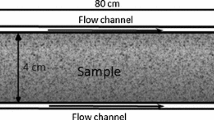Abstract
Rock–core column experiments were introduced to estimate the diffusion and sorption properties of Kuru Grey granite used in block–scale experiments. The objective was to examine the processes causing retention in solute transport through rock fractures, especially matrix diffusion used to estimate the importance of retention processes during transport in different scales and flow conditions. Rock–core columns were constructed from cores drilled into the fracture and were placed inside tubes to form flow channels in the 0.5 mm gap between the cores and the tube walls. Tracer experiments were performed using uranine, HTO, 36Cl, 131I, 22Na and 85Sr at flow rates of 1–50 µlmin-1. Rock matrix was characterized using 14C–PMMA method, scanning electron microscopy (SEM), energy dispersive X–ray micro analysis (EDX) and the B.E.T. method.
Solute mass flux through a column was modelled by applying the assumption of a linear velocity profile and a molecular diffusion. Coupling of the advection and diffusion processes was based on the model of generalised Taylor dispersion in the linear velocity profile. Experiments could be modelled applying a consistent parameterization and transport processes. The results provide evidence that it is possible to investigate matrix diffusion at the laboratory scale. The effects of matrix diffusion were demonstrated on the slightly–sorbing tracer breakthrough curves. Based on scoping calculations matrix diffusion begins to be clearly observable for non–sorbing tracer when the flow rate is 0.1 μl×min-1. The experimental results presented here cannot be transferred directly to the spatial and temporal scales that prevail in an underground repository. However, the knowledge and understanding of transport and retention processes gained from this study is transferable to different scales from laboratory to in–situ conditions.
Similar content being viewed by others
References
I. Neretnieks, T. E. Eriksen, and P. Tähtinen, Water Resourc. Res. 18 (4), 849 (1982).
P. Hölttä, “Radionuclie migration in crystalline rock fractures–Laboratory study of matrix diffusion,” Doctoral Thesis, University of Helsinki. Report Series in Radiochemistry 20/2002, 55 p. + Appendices (2002).
P. Hölttä, A. Poteri, M. Hakanen and A. Hautojärvi, Radiochimica Acta 92, 775 (2004).
A. Poteri and P. Hölttä, Technical Research Centre of Finland Research Report. VTT/PRO1/1008/05, 37 p (2005).
A. Poteri and P. Hölttä, Technical Research Centre of Finland Research Report. VTT-R-03919-06, 25 p. (2006).
K-H. Hellmuth, M. Siitari-Kauppi and A. Lindberg, Journal of Contaminant Hydrology 13, 403 (1993).
M. Siitari-Kauppi, “Development of 14C-polymethylmethacrylate method for the characterisation of low porosity media,” Doctoral Thesis, University of Helsinki. Report Series in Radiochemistry 17/2002, 156 p (2002).
A. Hautojärvi and V. Taivassalo, Nuclear Waste Commission of Finnish Power Companies. Report YJT-94-24 (1994).
Author information
Authors and Affiliations
Rights and permissions
About this article
Cite this article
Holtta, P., Siitari-Kauppi, M., Huittinen, N. et al. Determination of Matrix Diffusion Properties of Granite. MRS Online Proceedings Library 985, 1111 (2006). https://doi.org/10.1557/PROC-985-0985-NN11-11
Received:
Accepted:
Published:
DOI: https://doi.org/10.1557/PROC-985-0985-NN11-11



